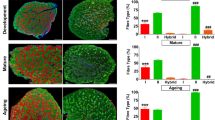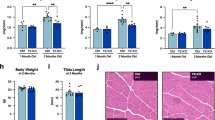Abstract
Vitamin C plays key roles in cell homeostasis, acting as a potent antioxidant as well as a positive modulator of cell differentiation. In skeletal muscle, the vitamin C/sodium co-transporter SVCT2 is preferentially expressed in oxidative slow fibers. Besides, SVCT2 is up-regulated upon the early fusion of primary myoblasts. However, our knowledge of the postnatal expression profile of SVCT2 remains scarce. Here we have analyzed the expression of SVCT2 during postnatal development of the chicken slow anterior and fast posterior latissimus dorsi muscles, ranging from day 7 to adulthood. SVCT2 expression is consistently higher in the slow than in the fast muscle at all stages. After hatching, SVCT2 expression is significantly down-regulated in the anterior latissimus dorsi, which nevertheless maintains a robust slow phenotype. Taking advantage of the C2C12 cell line to recapitulate myogenesis, we confirmed that SVCT2 is expressed in a biphasic fashion, reaching maximal levels upon early myoblasts fusion and decreasing during myotube growth. Together, these findings suggest that the dynamic expression levels of SVCT2 could be relevant for different features of skeletal muscle physiology, such as muscle cell formation, growth and activity.




Similar content being viewed by others
References
Bader D, Masaki T, Fischman DA (1982) Immunochemical analysis of myosin heavy chain during avian myogenesis in vivo and in vitro. J Cell Biol 95(3):763–770
Biressi S, Molinaro M, Cossu G (2007a) Cellular heterogeneity during vertebrate skeletal muscle development. Dev Biol 308(2):281–293
Biressi S, Tagliafico E, Lamorte G, Monteverde S, Tenedini E, Roncaglia E, Ferrari S, Cusella-De Angelis MG, Tajbakhsh S, Cossu G (2007b) Intrinsic phenotypic diversity of embryonic and fetal myoblasts is revealed by genome-wide gene expression analysis on purified cells. Dev Biol 304(2):633–651
Bryson-Richardson RJ, Currie PD (2008) The genetics of vertebrate myogenesis. Nat Rev Genet 9(8):632–646
Caprile T, Salazar K, Astuya A, Cisternas P, Silva-Alvarez C, Montecinos H, Millan C, de Los Angeles Garcia M, Nualart F (2009) The Na+-dependent l-ascorbic acid transporter SVCT2 expressed in brainstem cells, neurons, and neuroblastoma cells is inhibited by flavonoids. J Neurochem 108(3):563–577
Castro T, Low M, Salazar K, Montecinos H, Cifuentes M, Yanez AJ, Slebe JC, Figueroa CD, Reinicke K, de los Angeles Garcia M, Henriquez JP, Nualart F (2008) Differential distribution of the sodium–vitamin C cotransporter-1 along the proximal tubule of the mouse and human kidney. Kidney Int 74(10):1278–1286
Daruwala R, Song J, Koh WS, Rumsey SC, Levine M (1999) Cloning and functional characterization of the human sodium-dependent vitamin C transporters hSVCT1 and hSVCT2. FEBS Lett 460(3):480–484
DiMario JX, Stockdale FE (1997) Both myoblast lineage and innervation determine fiber type and are required for expression of the slow myosin heavy chain 2 gene. Dev Biol 188(1):167–180
Eldridge CF, Bunge MB, Bunge RP, Wood PM (1987) Differentiation of axon-related Schwann cells in vitro. I. Ascorbic acid regulates basal lamina assembly and myelin formation. J Cell Biol 105(2):1023–1034
Esteban MA, Pei D (2012) Vitamin C improves the quality of somatic cell reprogramming. Nat Genet 44(4):366–367
Franceschi RT, Iyer BS, Cui Y (1994) Effects of ascorbic acid on collagen matrix formation and osteoblast differentiation in murine MC3T3-E1 cells. J Bone Miner Res 9(6):843–854
Fredette BJ, Landmesser LT (1991) Relationship of primary and secondary myogenesis to fiber type development in embryonic chick muscle. Dev Biol 143(1):1–18
Frei B, England L, Ames BN (1989) Ascorbate is an outstanding antioxidant in human blood plasma. Proc Natl Acad Sci USA 86(16):6377–6381
Gordon T, Perry R, Srihari T, Vrbova G (1977) Differentiation of slow and fast muscles in chickens. Cell Tissue Res 180(2):211–222
Hughes SM, Taylor JM, Tapscott SJ, Gurley CM, Carter WJ, Peterson CA (1993) Selective accumulation of MyoD and myogenin mRNAs in fast and slow adult skeletal muscle is controlled by innervation and hormones. Development 118(4):1137–1147
Jackson MJ, Pye D, Palomero J (2007) The production of reactive oxygen and nitrogen species by skeletal muscle. J Appl Physiol 102(4):1664–1670
Kaprielian Z, Fambrough DM (1987) Expression of fast and slow isoforms of the Ca2+-ATPase in developing chick skeletal muscle. Dev Biol 124(2):490–503
Lee JY, Chang MY, Park CH, Kim HY, Kim JH, Son H, Lee YS, Lee SH (2003) Ascorbate-induced differentiation of embryonic cortical precursors into neurons and astrocytes. J Neurosci Res 73(2):156–165
Low M, Sandoval D, Aviles E, Perez F, Nualart F, Henriquez JP (2009) The ascorbic acid transporter SVCT2 is expressed in slow-twitch skeletal muscle fibres. Histochem Cell Biol 131(5):565–574
Low M, Sandoval D, Morales B, Nualart F, Henriquez JP (2011) Up-regulation of the vitamin C transporter SVCT2 upon differentiation and depolarization of myotubes. FEBS Lett 585(2):390–396
McGinley C, Shafat A, Donnely A (2009) Does antioxidant vitamin supplementation protect against muscle damage? Sport Med 39(12):1011–1032
Mitsumoto Y, Liu Z, Klip A (1994) A long-lasting vitamin C derivative, ascorbic acid 2-phosphate, increases myogenin gene expression and promotes differentiation in L6 muscle cells. Biochem Biophys Res Commun 199(1):394–402
Obinata T, Reinach FC, Bader DM, Masaki T, Kitani S, Fischman DA (1984) Immunochemical analysis of C-protein isoform transitions during the development of chicken skeletal muscle. Dev Biol 101(1):116–124
Padayatty SJ, Katz A, Wang Y, Eck P, Kwon O, Lee JH, Chen S, Corpe C, Dutta A, Dutta SK, Levine M (2003) Vitamin C as an antioxidant: evaluation of its role in disease prevention. J Am Coll Nutr 22(1):18–35
Palomero J, Jackson MJ (2010) Redox regulation in skeletal muscle during contractile activity and aging. J Anim Sci 88(4):1307–1313
Pansarasa O, Bertorelli L, Vecchiet J, Felzani G, Marzatico F (1999) Age-dependent changes of antioxidant activities and markers of free radical damage in human skeletal muscle. Free Radic Biol Med 27(5–6):617–622
Powers SK, Jackson MJ (2008) Exercise-induced oxidative stress: cellular mechanisms and impact on muscle force production. Physiol Rev 88(4):1243–1276
Powers SK, Criswell D, Lawler J, Ji LL, Martin D, Herb RA, Dudley G (1994) Influence of exercise and fiber type on antioxidant enzyme activity in rat skeletal muscle. Am J Physiol 266(2 Pt 2):R375–R380
Qiao H, May JM (2011) CpG methylation at the USF-binding site mediates cell-specific transcription of human ascorbate transporter SVCT2 exon 1a. Biochem J 440(1):73–84
Rando TA, Disatnik MH, Yu Y, Franco A (1998) Muscle cells from mdx mice have an increased susceptibility to oxidative stress. Neuromuscul Disord 8(1):14–21
Rumsey SC, Kwon O, Xu GW, Burant CF, Simpson I, Levine M (1997) Glucose transporter isoforms GLUT1 and GLUT3 transport dehydroascorbic acid. J Biol Chem 272(30):18982–18989
Rumsey SC, Daruwala R, Al-Hasani H, Zarnowski MJ, Simpson IA, Levine M (2000) Dehydroascorbic acid transport by GLUT4 in Xenopus oocytes and isolated rat adipocytes. J Biol Chem 275(36):28246–28253
Savini I, Catani MV, Rossi A, Duranti G, Melino G, Avigliano L (2002) Characterization of keratinocyte differentiation induced by ascorbic acid: protein kinase C involvement and vitamin C homeostasis. J Invest Dermatol 118(2):372–379
Savini I, Rossi A, Catani M, Ceci R, Avigliano L (2007) Redox regulation of vitamin C transporter SVCT2 in C2C12 myotubes. Biochem Biophys Res Commun 361(2):385–390
Schiaffino S, Reggiani C (1996) Molecular diversity of myofibrillar proteins: gene regulation and functional significance. Physiol Rev 76(2):371–423
Stadtfeld M, Apostolou E, Ferrari F, Choi J, Walsh RM, Chen T, Ooi SS, Kim SY, Bestor TH, Shioda T, Park PJ, Hochedlinger K (2012) Ascorbic acid prevents loss of Dlk1-Dio3 imprinting and facilitates generation of all-iPS cell mice from terminally differentiated B cells. Nat Genet 44(4):398–405
Stockdale FE (1992) Myogenic cell lineages. Dev Biol 154(2):284–298
Stockdale FE, Miller JB (1987) The cellular basis of myosin heavy chain isoform expression during development of avian skeletal muscles. Dev Biol 123(1):1–9
Tsukaguchi H, Tokui T, Mackenzie B, Berger UV, Chen XZ, Wang Y, Brubaker RF, Hediger MA (1999) A family of mammalian Na+-dependent l-ascorbic acid transporters. Nature 399(6731):70–75
Urso ML, Clarkson PM (2003) Oxidative stress, exercise, and antioxidant supplementation. Toxicology 189(1–2):41–54
Wigmore PM, Dunglison GF (1998) The generation of fiber diversity during myogenesis. Int J Dev Biol 42(2):117–125
Wilson JX (1990) Regulation of ascorbic acid concentration in embryonic chick brain. Dev Biol 139(2):292–298
Acknowledgments
Our work has been supported by the Chilean National Science and Technology Fund (FONDECYT) grant 1100326 (to JPH), as well as by the CONICYT ART-24091056 (to DS). DS, JO, and ML are CONICYT fellowship recipients. The authors thank member of our laboratories for useful discussion and comments on the manuscript.
Author information
Authors and Affiliations
Corresponding author
Rights and permissions
About this article
Cite this article
Sandoval, D., Ojeda, J., Low, M. et al. The vitamin C transporter SVCT2 is down-regulated during postnatal development of slow skeletal muscles. Histochem Cell Biol 139, 887–894 (2013). https://doi.org/10.1007/s00418-012-1075-4
Accepted:
Published:
Issue Date:
DOI: https://doi.org/10.1007/s00418-012-1075-4




